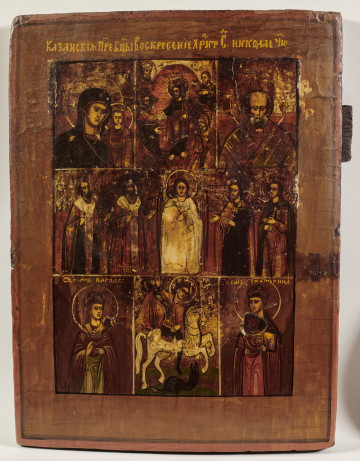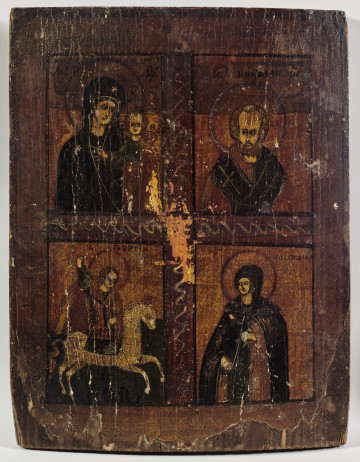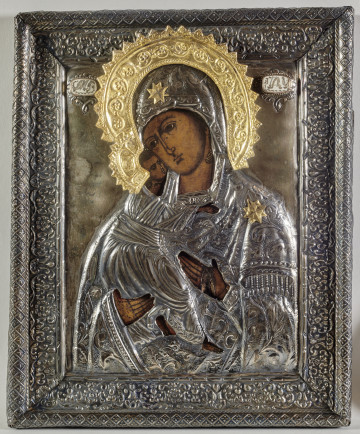
A multi-field icon, the Mother of God Odigitria of Kazan; the Resurrection of Christ; St. Nicholas, Archangel with saints; St. Barbara; St. George the Martyr, St. Catherine
2nd half of the 19th century
Castle Museum in Łańcut
Part of the collection: Varia
A rosary consisting of 56 circular beads. In the large part of the rosary, 50 small beads and 5 large beads made of expensive lapis lazuli have survived. In the smaller part of the rosary, under the central large bead, a tassel made of silk thread entwined with silver-gilt plate is fastened. Under the tassel, a separate bead is placed and underneath there is a cross composed of six large beads. The chains in the rosary are connected with a golden chain.
The lapis lazuli rosary has been a part of the Wilanów collection at least since 1856, when it was included as a work presented at an exhibition of antiquities and art objects – as the title of the accompanying publication indicates – ‘held in the Palace of His Excellency Count August Potocki and his wife in Warsaw at Krakowskie Przedmieście for the benefit of the Shelter Home of the Blessed Virgin Mary’. As J. Paprocka-Gajek writes, it was the first exhibition of treasures connected with the history of the partitioned country that were kept in family collections in Polish territories (J. Paprocka-Gajek, The Wilanów perspective of the Warsaw exhibition of antiquities in the Potocki Palace in the summer of 1856, in: ‘Studia Wilanowskie’, 2019). In the catalogue, the rosary is mentioned under the item no. 418, in the part listing the objects of the Potocki family from Wilanów: ‘A rosary of lazulite stone, set in gold, consisting of 50 smaller and 5 larger beads, smoothly crafted. At the bottom, it is suspended on three such beads, composed of six large lazulite balls and also set in gold and adorned with a golden tassel. It was probably made in Italy in the 17th century. The owner is Count August Potocki.’ The rosary derives from the Latin word ‘rosarium’, which stands for a rose garden, and the symbolism of this flower refers to the Hail Mary prayer addressed to Our Lady. The structure of the prayer is based on the contemplation of four secrets of rosary referring to events from Mary’s life through the repetition of the angel’s call Hail Mary. The prayer in this form was approved for the Catholic Church by Pope Pius V in 1569.
Author / creator
Dimensions
entire object: height: 61,0 cm, width: 7,0 cm
Technique
rolling,polishing,gilding
Material
gold,silk thread
Owner
Museum of King Jan III's Palace at Wilanów
Identification number
Location / status

2nd half of the 19th century
Castle Museum in Łańcut

XIX/XX wiek
Castle Museum in Łańcut

początek XX w.
Castle Museum in Łańcut
DISCOVER this TOPIC
National Museum in Szczecin
DISCOVER this PATH
Educational path